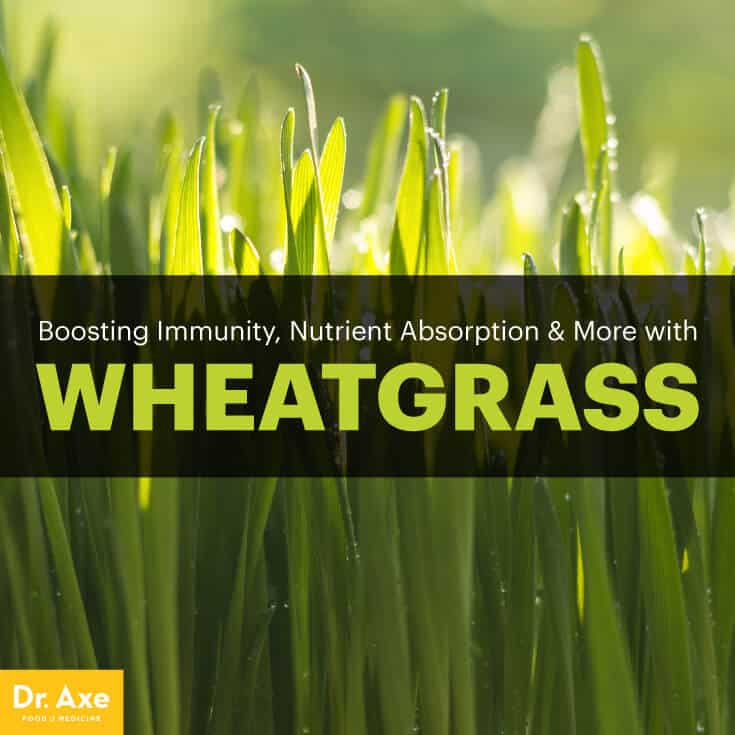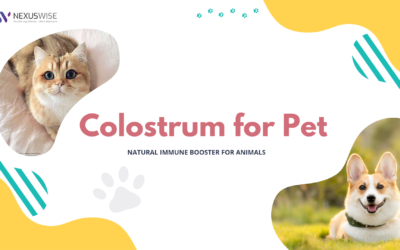According to surveys conducted by the Center for Disease Control, only about 27 percent of Americans get more than three servings of vegetables per day. (1)
Most of us know by now that we need to be eating fresh fruits and veggies everyday in abundance for optimal health and detoxification. However, for many people this isn’t as easy as it might seem. While it isn’t meant to replace eating fresh vegetables, wheatgrass benefits provide numerous antioxidants and other nutrients, all in one small easy-to-drink glass.
What Is Wheatgrass?
Wheatgrass is the young grass of the common wheat plant called triticum aestivum. (2) This (gluten-free, of course!) edible grass is either juiced into a “wheatgrass shot,” or milled down into a fine green powder that’s used to create a multipurpose product for both humans and animals.
Types of wheatgrass:
Wheatgrass can be consumed on its own, or used in combination with other juices or supplements. Now considered to be a “superfood,” several forms of wheatgrass that are becoming more widely available include:
- Juice
- Capsules
- Powder
- Pills
- Tablets
Which type is best? The best way to consume all foods is as close to their natural state as possible. For wheatgrass, this means that drinking it in juice form (“shots” as they’re called) would be preferred over consuming it in tablet or powder form. You can either visit an establishment that sells freshly made wheatgrass shots or try making them on your own (more on this below).
If you aren’t able to find fresh wheatgrass, wheatgrass powder makes a good second option. And if convenience is what you’re really after, high-quality (pure) wheatgrass tablets are certainly beneficial as well.
Wheatgrass Nutrition Facts
Some experts claim that wheatgrass contains over 100 different elements needed by man. One of the most noticeable (and important) nutrients in wheatgrass is chlorophyll. (3)
Chlorophyll is the substance that gives wheatgrass its signature, bright green color. Like other nutrient-dense greens, it’s used in the human body for a number of important processes: It’s a natural liver cleanser and detoxifier, acts like an antioxidant to reduce free radical damage, is a blood strengthener (it has a similar chemical composition to that of hemoglobin,) and can help give you a boost in energy.
But chlorophyll is not all wheatgrass has to offer. Wheatgrass benefits also include being loaded with amino acids (the building blocks of proteins), enzymes which are needed for digestion, and many vitamins and minerals needed for disease-free living.
Wheatgrass is rich in the following nutrients: (4)
- Chlorophyll
- Antioxidants like flavonoids and phenolic acid
- Iron
- Electrolytes including magnesium and calcium
- Amino Acids
- Vitamin A
- Vitamin C
- Vitamin E
- Selenium
21 Wheatgrass Benefits
Wheatgrass is a potent source of a number of vital nutrients your body can’t do without. Dozens of studies on wheatgrass — and also its individual antioxidants and nutrients — show that its health benefits include:
- Supplying a high dose of chlorophyll
- Encouraging a highly oxygenated environment in your body
- Promoting a healthy metabolism
- Establishing an alkaline environment in the body
- Acting as an antibacterial by halting growth of unfriendly bacteria
- Rebuilding and strengthening blood
- Restoring fertility and balancing hormones
- Rebuilding damaged tissue
- Detoxifying the body of heavy metals
- Purifying liver
- Helping with blood sugar regulation
- Acting as an antiseptic to treat odors, strep infections, wounds, skin grafts, sinusitis, ear infections, varicose veins and scars
- Helping to prevent tooth decay
- Aiding in sore throat pain reduction
- Fighting skin conditions such as eczema and psoriasis
- Improving digestion
- Reducing inflammation
- Improving eyesight, particularly night vision
- Helping with sleep
- Boosting the immune system
- Improving nerve signaling and mental well-being
Here are the four most prominent wheatgrass benefits:
1. Alkalizing the Body & Boosting Nutrient Absorption
Wheatgrass provides vital alkalizing benefits for the body, along with increasing absorption of nutrients like electrolytes, vitamin C and vitamin E. If you want to prevent cancer and other chronic diseases from flourishing in your body as you get older, creating an alkaline environment is essential.
Acidosis (high levels of acid resulting from low alkalinity) is an all-too-common problem today, due to toxicity from the environment along with many people eating highly processed foods. Cancers and other diseases flourish in acidic environments, but cease to exist in alkaline ones.
What gives wheatgrass the ability to prevent acidosis? Chlorophyll is primarily responsible. Chlorophyll has been shown to help naturally balance the body’s pH level and protect cells. This is one of the reasons that chlorophyll consumption is associated with anti-aging effects ranging from younger-looking skin to better weight management.
2. Lowering Free Radical Damage
Wheatgrass benefits including having strong antioxidant capabilities and can also lower oxidation/free radical damage that causes aging and contribute to disease formation. Studies have found that wheatgrass can significantly inhibit lipid peroxidation in the liver and protect mitochondria within cells. This is tied to reduced inflammation levels and lower risk for diseases like cancer, liver disease and heart disease.
Research regarding the antioxidant levels (ORAC values) of various “superfoods” has found that wheatgrass has an ORAC score “higher than those reported for many other natural extracts or vegetables”. (5) Work done by the Department of Pharmacology at Gajara Raja Medical College in India has shown that some of the antioxidants present in wheatgrass include: (6)
- phenolic compounds
- flavonoids
- sulfonic acid
- DPPH (1,1′-diphenyl-2-picrylhydrazyl)
- triterpenoids
- anthraquinol
- alkaloids
- tannins
- saponins
3. Raising Immunity & Cancer Protection
Studies have found that wheatgrass demonstrates anti-cancer potential, and that it seems to do so through the mechanism of inducing apoptosis(self-destruction of cancerous cells). According to research done by the Integrated Oncology and Palliative Care Unit in Israel, wheatgrass can be effectively used in holistic cancer treatment programs (even those that also use conventional treatments like chemotherapy), and also for cancer prevention. (7) Its benefits for overall immune function include regulating immunological activity and fighting oxidative stress that contributes to cell mutations.
Research shows that wheatgrass can also help attenuate chemotherapy-related side effects such as fatigue, malabsorption and deficiencies. Other than helping to prevent and treat cancer, clinical trials show that wheatgrass may induce synergistic benefits to those with other immune-related conditions such as rheumatoid arthritis, ulcerative colitis, hematological diseases, diabetes and obesity.
4. Lowering High Cholesterol & Triglycerides
Studies conducted at Sharma University of Health Sciences in India show that wheatgrass is a medicinal plant for the heart and blood vessels — it can be effective in treating hyperlipidemia (it helps lower high cholesterol and triglyceride levels along with increases in inflammation and oxidative stress).
One study examined the effects of wheatgrass given to rabbits eating a high-fat diet that induced hyperlipidemia. Thirty rabbits were divided into three groups: one receiving a control diet, one receiving a high-fat diet, and a group receiving a high-fat diet together with wheatgrass over a period of 10 weeks.
Fasting serum samples from the animals were analyzed for total cholesterol (TC), high-density lipoprotein cholesterol (HDL-C), malondialdehyde (MDA), reduced glutathione (GSH) and vitamin C, and the results were compared. The high-fat diet resulted in hyperlipidemia and an increase in oxidative stress, along with lowered glutathione antioxidant levels and lowered vitamin C. However, wheatgrass supplementation taken along with a high-fat diet resulted in improved lipid levels (decreased total cholesterol and increased HDL-C). Wheatgrass also significantly reduced MDA levels and increased glutathione and vitamin C levels. (8)
How to Use Wheatgrass Products
No matter what your current state of health is, you can benefit from adding wheatgrass — especially fresh wheatgrass juice — to your daily diet. Growing your own wheatgrass is easy, affordable and the very best way to get fresh wheatgrass regularly. Once you have access to your own wheatgrass, you can add a small amount daily to drinks, smoothies, plain water or other recipes. This is a great way to get all of your chlorophyll and veggies in one shot, literally!
Wheatgrass starter kits can be purchased online for little money. You might choose to buy a wheatgrass kit that includes a bundle of things you’ll need, or simply buy the needed materials such as seeds and a juicer separately. The most nutrient-dense wheatgrass is grown in very healthy soil, so always make sure to purchase organic soil whenever possible. Keep in mind it’s important to clean all equipment thoroughly to prevent bacteria growth, which can sometimes be the case with fresh grasses or sprouts. (9)
Once you grow your own wheatgrass, you’ll need to use either a juicer (the preferred method) or a high-speed blender to freshly press the grass into liquid form. A small amount of wheat grass goes a long way, and making your own juice will save you lots of money in the long run (wheatgrass shots tend to be expensive when store-bought).
If you prefer not to grow your own wheatgrass, look for a store-bought green powder mix that contains dried wheatgrass. These products tend to combine a dozen or more different grasses and high-antioxidant foods into one, are easy to use, and can save you lots of time.
Precautions When Using Wheatgrass
Although research exists showing the benefits of wheatgrass, there have still not been many studies done long-term showing possible interactions of wheatgrass or revealing much information about whether or not it might trigger allergies in some people.
Most of the wheatgrass benefits we know about come from people who have used it for years and can attest to its positive affects. However, not every claim can be backed up yet with well-controlled scientific studies. Overall, it’s best to use wheatgrass as part of a balanced, healthy diet and not in place of whole vegetables or fruits.
That being said, wheatgrass is generally considered safe and has little risk of causing any side effects for most people. Rarely people have experienced adverse reactions from wheatgrass including allergic reactions (which usually happen right away after consuming it), digestive discomfort, nausea, headaches, hives or swelling of the throat. (11)
Wheatgrass is a raw food: it’s usually grown in soil or water and consumed without being cooked, which means it could be contaminated with food-borne bacteria or mold in rare cases, so if you’re pregnant it might be best to either grow your own or avoid consuming it. If you have a known allergy to other grasses, wheat or ingredients commonly found in supplements, then always check with your doctor before using wheatgrass.
(Source: https://draxe.com/discover-amazing-wheat-grass/ )




